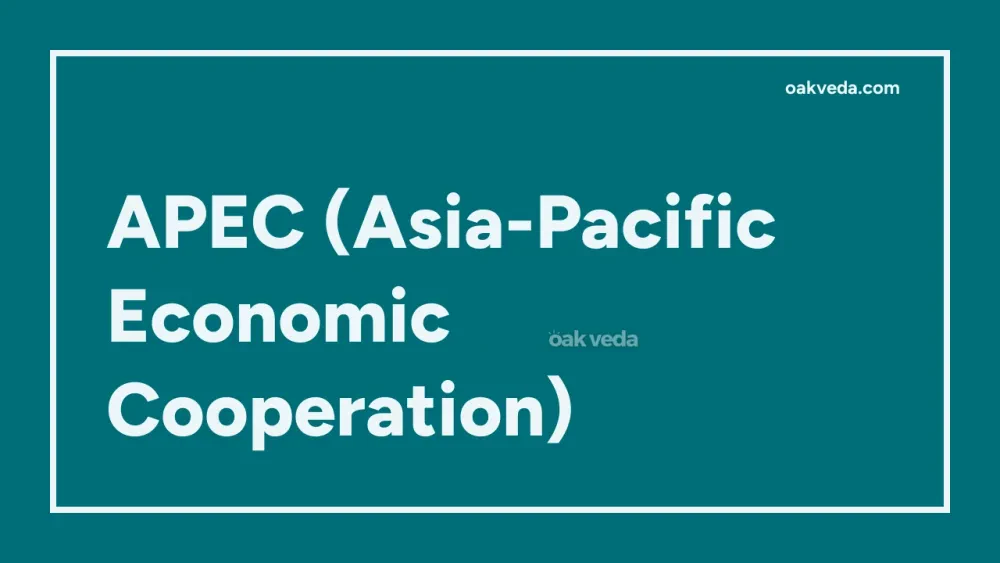
What is the Full Form of APEC?
APEC is the acronym for Asia-Pacific Economic Cooperation. This regional economic forum was established to leverage the growing interdependence of Asia-Pacific economies and promote free trade throughout the region.
What is Asia-Pacific Economic Cooperation?
Asia-Pacific Economic Cooperation is a forum of 21 member economies from the Pacific Rim that aims to promote free trade and economic cooperation throughout the Asia-Pacific region. APEC works to create greater prosperity for the people of the region by fostering balanced, inclusive, sustainable, innovative, and secure growth through accelerating regional economic integration.
Origin and Development of APEC
The Asia-Pacific Economic Cooperation was founded in 1989 in response to the growing interdependence among Asia-Pacific economies. Here's a brief timeline of APEC's development:
- 1989: APEC is established with 12 founding members
- 1993: Leaders' Meetings are established, elevating APEC to a summit-level forum
- 1994: APEC sets the Bogor Goals for free and open trade and investment in the region
- 1995: APEC adopts the Osaka Action Agenda, providing a framework to meet the Bogor Goals
- 2020: APEC leaders adopt the Putrajaya Vision 2040, setting a new direction for the forum
APEC's Secretariat, responsible for coordination, technical support, and communications, is headquartered in Singapore.
How does APEC work?
APEC operates on the basis of non-binding commitments, open dialogue, and equal respect for the views of all participants. Unlike the WTO or other multilateral trade bodies, APEC has no treaty obligations required of its participants. Decisions made within APEC are reached by consensus, and commitments are undertaken on a voluntary basis.
Functions of APEC
The primary functions of APEC include:
-
Facilitating trade and investment: APEC works to reduce tariffs and non-tariff barriers to trade and investment.
-
Promoting regional economic integration: The forum encourages closer economic ties among member economies.
-
Enhancing economic and technical cooperation: APEC fosters collaboration in areas such as human resource development, energy, telecommunications, and tourism.
-
Ensuring human security: The forum addresses issues like emergency preparedness, health security, and counter-terrorism.
-
Promoting sustainable development: APEC works towards environmentally sustainable growth and development.
Applications of APEC
APEC's work impacts various sectors and aspects of the Asia-Pacific economy:
- Trade facilitation: Simplifying customs procedures and reducing transaction costs
- Digital economy: Promoting e-commerce and digital trade
- Structural reform: Improving regulatory systems and promoting good governance
- Human capital development: Enhancing skills and education to meet the needs of the digital age
- Small and medium enterprises: Supporting the growth and internationalization of SMEs
Features of APEC
Key features that distinguish APEC include:
- Voluntary and non-binding nature: Commitments are made on a voluntary basis
- Open regionalism: APEC's initiatives benefit both members and non-members
- Consensus-based decision-making: All decisions are made by consensus
- Public-private partnership: Strong engagement with the business community through APEC Business Advisory Council (ABAC)
Benefits of APEC
APEC membership offers several benefits:
- Increased trade and investment: Members have seen significant growth in intra-regional trade
- Economic reforms: APEC encourages domestic reforms to enhance competitiveness
- Capacity building: Members benefit from knowledge sharing and best practices
- Networking opportunities: Annual meetings provide a platform for high-level networking
- Voice in regional economic matters: Members can influence regional economic policies
Limitations or Challenges of APEC
Despite its successes, APEC faces several challenges:
- Non-binding nature: The voluntary nature of commitments can lead to slow progress
- Diverse membership: Wide economic disparities among members can complicate consensus-building
- Overlapping regional initiatives: Competition from other regional forums and FTAs
- Criticism of being a "talk shop": Perceived lack of concrete outcomes in some areas
Future Developments in APEC
Looking ahead, APEC is focusing on:
- Digital transformation: Harnessing technologies like AI, IoT, and blockchain
- Inclusive growth: Ensuring the benefits of economic growth reach all segments of society
- Green growth: Promoting sustainable, environmentally friendly economic practices
- Regional economic integration: Working towards the Free Trade Area of the Asia-Pacific (FTAAP)
- Post-pandemic recovery: Collaborating on strategies for economic recovery and resilience
FAQs on APEC Full Form
-
How many members does APEC have? APEC has 21 member economies.
-
What is the difference between APEC and ASEAN? While APEC focuses on economic cooperation across the broader Asia-Pacific region, ASEAN (Association of Southeast Asian Nations) is a more formal intergovernmental organization focusing specifically on Southeast Asian countries.
-
Is APEC a free trade agreement? No, APEC is not a free trade agreement. It's a forum aimed at facilitating economic growth, cooperation, trade, and investment in the Asia-Pacific region.
-
How often do APEC leaders meet? APEC leaders meet annually at the APEC Economic Leaders' Meeting.
-
Can new members join APEC? APEC currently has a moratorium on new membership. The last member to join was Peru in 1998.
In conclusion, the Asia-Pacific Economic Cooperation (APEC) plays a crucial role in fostering economic growth and cooperation in the Asia-Pacific region. Despite challenges, its commitment to open dialogue and consensus-building continues to shape the economic landscape of this dynamic and diverse region.
You may be interested in:

